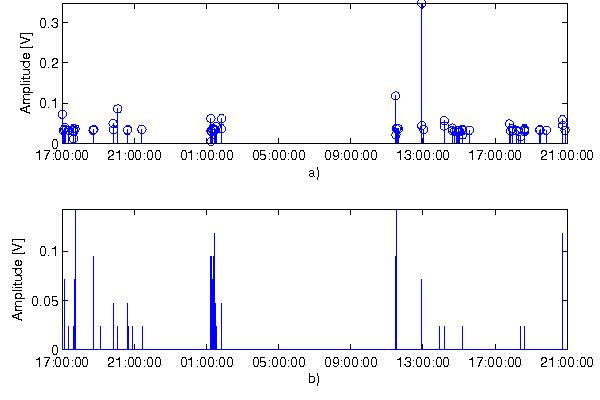Two tests of the platform were performed. The first occurred in
November 2006, aboard a cargo ship travelling between Singapore and
Kaohsiung, Taiwan. The results of this test were unsatisfactory, and
although some sensors lasted for over a month in the field, many
failed much sooner, due to excessive power consumption. Also, not all
the novel sensors developed for the platform worked as expected.
After the tags returned from Asia, the bugs were fixed, and the tags
sent out for another test in January 2007. This time, they were
placed in a DHL express courier box, and sent by air between Boston
and San Francisco. A current meter was connected to one of the tags
to measure instantaneous current consumption, and the tag was able to
maintain 23.7 uA current consumption while responding to
external stimuli.

10-minute average power consumption of the tag during its journey
between Boston and San Francisco. Periods of increased activity
result in tag wakeups and therefore higher power consumption. The
descriptions were taken from the courier service's package-tracking
Web site.

The various sensors on the platform provide differing perspectives on
the same phenomenon. From top to bottom: tilt switch, vibration
dosimeter, and piezoelectric microphone.

In an effort to limit wakeups from aftershocks and increase battery
life, the piezo microphone attached to the tag was subject to a
dynamic threshold. As can be seen from the figure, the threshold
increases with each wakeup, giving the tag respite from excessive
stimulation.

The above two plots compare the stimuli recorded by the shock-sensor
quasi-passive wakeup mechanism with dynamic thresholds of the CargoNet
tag (top) to that of a tag sampling at 2 Hz (bottom).

As before, the top plot compares the events recorded by the
quasi-wakeup system while the bottom shows the events sampled at 2 Hz.
In this case, the sensor used is the piezoelectric microphone. The
plots show good correspondence between the two tags, demonstrating
that quasi-passive wakeup and dynamic thresholds are a valid
substitute for periodic sampling.





